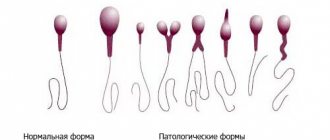Pregnancy after 40 years is now not uncommon, but rather a trend. Both in Russia, and especially in European countries, a woman first prefers to strengthen her social and material positions, and then become a mother. A reasonable decision to wait sometimes results in difficulties in conceiving and carrying a long-awaited pregnancy. In our article we will look at the really existing risks for older pregnant women.
A second pregnancy after 40 years has almost the same features as the first. Especially if there was a long break in childbirth.
Planning pregnancy after forty
In general, it is always advisable to plan pregnancy. At the age of 40 or more, this aspect becomes especially important. Over time, we gain not only experience and material well-being, but also accumulate somatic pathology. As a rule, by the age of 40, a woman has one or more chronic diseases. In a non-pregnant state, they are in remission (spontaneously or under the control of taking medications), and during pregnancy a pronounced exacerbation can occur.
Exacerbation of chronic diseases is a risk to life and health of both mother and fetus.
Pre-pregnancy examination
1. Examination by an obstetrician-gynecologist. 2. Smear for flora + gonococci and trichomonas. 3. Cytological examination of scrapings from the cervical canal to identify atypical cells. 4. Ultrasound of the pelvic organs. It is necessary to know about the presence/absence of uterine fibroids (and its size, type of node, location and blood supply), ovarian cysts. 5. Fluorography. Routine examination that cannot be performed during pregnancy. You need to know that you have reached the moment of conception without pathological lesions in the lungs. Of course, pulmonary tuberculosis carries a special life and social risk. 6. General blood and urine tests, biochemical blood test 7. PCR for common STIs (chlamydia, trichomonas, gonorrhea, mycoplasma) 8. ELISA for HIV, hepatitis B and C 9. RMP to detect syphilis 10. Examination by a therapist. You must explain to the general practitioner that you are planning a pregnancy and want to eliminate health risks, and also decide on the fundamental possibility of bearing a child.
According to indications, the therapist may recommend you: - ECG. — EchoCS (ultrasound of the heart). — Ultrasound of internal organs and kidneys. — Examination of the spine and pelvic bones, if there have been episodes of injury, there is a suspicion of diseases of the musculoskeletal system. — Ultrasound of the vessels of the lower extremities (if there is a history of varicose veins, episodes of thrombophlebitis, phlebothrombosis, atherothrombosis). And other highly specialized studies and consultations with narrow specialists (hematologist, cardiologist, pulmonologist and others).
Pros and cons of late pregnancy
Having a late child has both its advantages and relative disadvantages. Pregnancy at 40 or even later has the following advantages:
- Mindfulness . By this age, a woman already knows for sure that she wants a child. As a rule, she has already established herself in her career and has gained confidence in her abilities. Therefore, having become a mother, a woman will treat her baby more carefully than a young mother.
- Availability of material resources . By the age of 40, a woman usually already has financial reserves, which will help her easily bear material costs while carrying a child and in the first years after his birth.
- Marriage relationships proven over the years . Usually, at an older age, a married couple is already confident in each other’s feelings, the woman is not afraid of losing her husband, marital relationships become stable and calm.
The main disadvantages are the longer recovery period after childbirth and the wariness of medical specialists who are wary of such women. In addition, some older mothers worry whether they will have time to raise their child until he grows up.
Pregnancy at 40, however, as at any age, should be desired. If a woman wants to become a mother and has managed to conceive, nothing should stop her from carrying the baby to term. The main thing is to follow the doctor’s recommendations and listen to your body, waiting for the time of a miracle - the birth of a child.
Contraindications to pregnancy after 40 years:
1) Diabetes mellitus type 1 or 2 with an uncompensated, labile course, high blood sugar levels, and frequent hypoglycemic conditions. 2) Arterial hypertension, heart defects, accompanied by circulatory disorders of stage IIb - III. As well as heart defects complicated by infective endocarditis and/or rhythm disturbances. The rhythm disturbance must be established, accurately diagnosed (24-hour ECG monitoring) and recommendations from a cardiologist must be obtained regarding the possibility of pregnancy and recommended therapy compatible with pregnancy. 3) Oncological diseases. Oncopathology of any localization requires treatment before pregnancy, since chemotherapy and radiological (radiation) treatment are detrimental to the fetus. 4) Blood diseases. Contraindications to pregnancy include severe anemia, leukemia, lymphoma, severe thrombocytopenia, porphyria, and myelodysplastic syndromes. 5) Autoimmune diseases (diffuse connective tissue diseases). This refers to diseases such as systemic lupus erythematosus, systemic scleroderma, dermatomyositis. In each case, the issue should be resolved individually. Perhaps compensation for the condition and selection of adequate therapy will make it possible to bear a child. 6) Acute diseases and chronic kidney diseases in a state of exacerbation, the presence of renal failure. Adequate treatment and additional examination may make it possible to bear a child with full compensation for the condition.
Preparing for pregnancy after forty
This is preparation for conception for at least 3 months.
— It is necessary to sanitize foci of infection (heal teeth, treat tonsillitis), quit smoking, alcohol, and strong drugs (sleeping pills, antidepressants, etc.). If you have a chronic disease that requires lifelong medication, you must consult with an obstetrician-gynecologist and a specialized specialist (rheumatologist, cardiologist, etc.) to select medications that are acceptable during pregnancy.
— You also need to start taking folates (folic acid, metafolin), which significantly reduce the risk of having a child with deformities. A particularly close connection has been identified between a lack of folate in the expectant mother and defects in the nervous system of the fetus (malformations of the brain and spinal cord, often incompatible with life).
— In regions where goiter is endemic (damage to the thyroid gland), you should take a prophylactic dose of iodine (iodomarin, potassium iodide 150 - 200 mcg).
It is possible to take complex medications that include the microelements necessary for the expectant mother (Femibion Natalcare I).
Features of pregnancy after forty years
First trimester
The first trimester is a very important period, right now the laying of all the organs of the future baby is taking place.
— Taking folic acid or metafolin supplements (an available form of folate). You can take folic acid in a dosage of 400 mcg (folic acid 9 months, mamifol) 1 tablet 1 time per day for up to 12 weeks. If during the preconception period you took a complex drug with folates (Femibion Natalcare I), then continue taking it for up to 12 weeks, and then you can switch to taking the supplemented Femibion Natalcare II complex, or change the drug to other complex vitamins (Elevit pronatal, Vitrum prenatal, complies trimester).
— If there have been difficulties with conception, a period of infertility, or there is a threat of miscarriage from an early stage, then it is advisable to carry out hormonal support of pregnancy with progesterone preparations (duphaston, utrozhestan, prajisan).
— I screening is always carried out according to an expanded scheme:
Ultrasound - screening, biochemical screening and often amniocentesis.
Biochemical screening is the determination of markers of fetal chromosomal abnormalities in the mother's blood. The three most common chromosomal abnormalities are most often diagnosed: Down syndrome, Edwards syndrome, and Patau syndrome. This study must be carried out simultaneously with the first ultrasound screening at 12 weeks. With an earlier blood sample, the result may be unreliable; with a later sample, the risk of complications of termination of pregnancy is increased if gross anomalies are detected and termination is indicated for medical reasons.
Amniocentesis is an invasive diagnostic method that involves puncture of the amniotic sac and collection of amniotic fluid (amniotic fluid) for laboratory testing. Amniocentesis can be early (8 - 14 weeks) or late (15 weeks or more). In each case, the question of the need and timing of amniocentesis is decided individually. The patient should be made aware of the risks and complications of the procedure and may refuse this type of diagnosis. But amniocentesis is a highly accurate diagnostic method, therefore, in controversial cases and in the absence of contraindications, it is used quite often.
With the help of amniocentesis, chromosomal abnormalities and fetal malformations are confirmed or refuted with a very high probability.
Chorionic villus biopsy may also be performed if indicated.
Chorionic villus biopsy is also an invasive diagnostic method; it is performed somewhat less frequently than amniocentesis; the collection of material is technically more difficult and the risk of complications is greater. However, the high diagnostic value makes this method an expert one. Chorionic tissue is collected; 15 mg of tissue is enough for a full analysis of many developmental defects and determination of the karyotype (chromosome set). A chorionic villus biopsy is performed at 9.5 - 12 weeks.
First signs and early symptoms of pregnancy
SIGNS OF PREGNANCY IN THE 1st WEEK Doctors usually consider the first day of the last menstruation to be the starting point of pregnancy. Although pregnancy has not yet occurred, the woman’s body has already begun preparing for this wonderful event. Conception occurs much later, only in the third week. How to prepare so that the desired pregnancy occurs as early as possible and proceeds successfully? Let's discuss the main stages of preparation before finding out what the first signs of pregnancy are typical for 1 week from the moment of conception. At the end of the first week, it is worth paying special attention to the actual conception of the child. To ensure that the chances of conception are as high as possible, doctors advise taking a three-day break from intimate life before the moment of possible conception. Male reproductive cells are spermatozoa that are quite sensitive to the chemical composition of the environment into which they enter. The most favorable positions for conceiving a child are the so-called missionary position and the knee-elbow position of a woman, in which the man is behind. To increase the likelihood of conception, it is worth spending twenty to thirty minutes after intercourse lying on your back. You can elevate your pelvic area by placing a folded blanket or pillow under your lower back. If you have animals in your home - cats, dogs and other pets, have them examined by a veterinarian and get all the necessary vaccinations. Take timely prevention of colds.
Measuring basal temperature every morning is a useful habit for a woman planning to become a mother soon. If possible, try to avoid stressful situations and nervous shocks. When planning a pregnancy in advance, 1 week of pregnancy should be marked not only by visiting a doctor, but also by taking vitamin complexes. In most cases, the gynecologist prescribes an ultrasound between 5 and 11 days of the cycle. This is necessary to control the process of follicle growth. In addition, an ultrasound will allow your doctor to determine the exact day of ovulation and identify possible hormonal imbalances in a woman. Signs of pregnancy at 1 week are not so noticeable, but nevertheless, a woman often notices the following changes: increased salivation. The 1st week of pregnancy is often marked by the formation of drool in the mouth on its own. This happens not only before a meal, when you are hungry and see delicious treats on the table, but also after a meal; calf cramps, which especially often occur at night, may also indicate that you are 1 week pregnant; Another common sign of pregnancy at 1 week is a metallic taste in the mouth and changes in pigmentation. Already a week after conception, the white line of the abdomen, which starts from the navel and goes down, may darken. It is also possible for pigment spots to appear on the face, along the hairline; bloating of the abdomen, as well as sudden constipation from any food, are among the most embarrassing of the first signs of pregnancy. The pregnancy period is counted from the first day of the last menstruation for several reasons. Among the main reasons is convenience, since the start date of menstruation is remembered depending on the date of conception. Conception can occur not necessarily on the day of sexual intercourse, but even within 3 days after intimacy. According to global practice, the fertilization stage lags behind by 2 weeks from the beginning of the menstrual cycle. This delay is usually called the ovulation period. Menstruation is a process of renewal of the female reproductive system and preparation of the body for ovulation and conception. At the same time, the ovary prepares for the possibility of the egg giving birth to a new life. The gestational (or obstetric) period of pregnancy is 40 weeks, that is, 10 months of 4 weeks each, for a total of 280 days. The obstetric period is divided into 3 trimesters: the first lasts from 1 to 12 weeks, the second from 13 to 27 weeks, the third from 28 to 40 weeks. In order to predict the birth of a baby by a certain date, you can calculate the estimated date of birth using the following method: add 7 days to the date of the start of the last menstruation and count back 3 months. HOW LATE PREGNANCY PROCEEDS (AFTER 30.35 OR AFTER 40 YEARS OLD) IN A WOMAN If we compare the possibility of getting pregnant at the age of slightly over 30 compared to when a woman is almost 40, then the difference is huge. The closer your age gets to 40 years, the weaker your body’s ability to conceive. Experts around the world advise women over 30 not to wait too long, especially if they plan to have more than one child. Pregnancy after 30 years will proceed without much difference from pregnancy at an earlier age. The ability to conceive and the risk of miscarriage or having a child with Down syndrome are only a couple of percentage points higher than for women aged 26 to 28 years. After 35 years, a woman's fertility begins to decline sharply. Also, pregnancy after 35 years is marked by an increased risk of having a child with Down syndrome or other congenital malformations. Doctors may advise the expectant mother to undergo a number of examinations: amniocentesis, chorionic villus biopsy and some others. For women between the ages of 35 and 39, the chances of conceiving twins increase many times over even without prior infertility treatment. Typically, infertility treatment promotes multiple pregnancies. Typically, during one menstrual cycle, a woman matures one egg, but the level of the hormone that stimulates the follicles (FSF) increases with age. Pregnancy after 40 years has a number of advantages. Among them is the fact that since you were in no hurry to have children before, it means you were busy with career and personal growth, and managed to see the world. Your financial well-being provides a secure foundation for family life. Women at an older age are better educated, unlike young mothers, they make reasonable and informed decisions. Women after 40 years of age are more inclined to breastfeed, they eat healthy food and take care of the child. The main disadvantage of having a child after 40 years of age is the difficulty of conception. It has been scientifically proven that 15 years before the onset of menopause, the number of eggs produced that mature in a woman’s body begins to decline sharply. In addition, mature eggs may have chromosomal problems, which leads to an increased risk of miscarriage and birth defects in the child. IS IT POSSIBLE TO GET PREGNANT FROM MUCUUS (PRE-EJACULATION FLUID)? Sexual contact occurs in cases where the body of both partners is completely ready for it. To ensure that intimate intimacy brings pleasure and not pain, the reproductive organs of both women and men secrete a special natural lubricant. This lubricant looks like colorless mucus and serves as evidence that the partner is in an aroused state. In men, lubricant is a pre-ejaculatory fluid that is released during intimacy and looks like clear, odorless mucus. Nature has provided this mucus as a lubricant for easier penetration of the genital organ. The female body secretes the same fluid, but it has nothing to do with pregnancy. With male mucus, things are a little more complicated. Many young girls wonder: “ Is it possible to get pregnant from male mucus during intimate contact?” “Experts answer that you can get pregnant from mucus, but the likelihood of this is negligible. Studies have confirmed that some men have sperm in their secretions (lubrication), but the number of such men is not at all large. Find out the answer to the question “Is it possible to get pregnant from mucus during intimacy?” only possible through expensive tests. WHAT EARLY SYMPTOMS OF PREGNANCY CAN APPEAR IN THE FIRST DAYS? Only a gynecologist or a pregnancy test can determine pregnancy with a high probability, but let's talk about what early symptoms of pregnancy can be determined independently. The only way to most accurately determine pregnancy before visiting a doctor is a test. Some pregnancy symptoms already in the first days after conception will tell you that the woman is in an interesting position. Some women feel their bodies so sensitively that they almost immediately feel that they are pregnant. Other women do not feel anything until their period is missed. A delay is the most obvious sign of pregnancy. The first symptoms of pregnancy can vary greatly from woman to woman. Even in the same woman, during her second pregnancy, symptoms may differ from those she observed during her first pregnancy. What early pregnancy symptoms can a woman see on her own? Strong cravings for salty foods, changes in taste preferences, increased irritability and nervousness. The expectant mother sometimes has poor control over her behavior, although she understands that behavior does not always correspond to the norm. Symptoms of pregnancy in the first days are mild nausea or nausea at certain periods of time, which is called early toxicosis. Toxicosis can manifest itself as a pronounced sensation with every meal or simply mild nausea in the morning. Also, at the beginning of pregnancy, the perception of smells and tastes may change, and an aversion to any food may occur. Sometimes a metallic taste appears in the mouth. In the early stages of pregnancy, breast enlargement is especially noticeable. Conception in the very first days gives rise to rapid hormonal changes in a woman’s body. After just a couple of weeks, the breasts may become one or two sizes larger, and sensitivity increases. FIRST SIGNS OF PREGNANCY IN THE EARLY TERMS Some signs of pregnancy in the first days turn out to be more accurate than a regular pregnancy test. At a very early stage, the test may not show the desired second stripe. Even if conception has occurred, the hCG level may be so low that the test will not be able to detect its increase. The first signs of pregnancy can also be determined by the appearance of acne, even if you have never had such a problem. With standard fetal development, the immune system of the expectant mother is suppressed. Nature provided this so that the body does not reject the embryo as a foreign body. As a result of this, the expectant mother becomes very susceptible to various types of infections. By regularly monitoring your cycle and measuring your basal temperature, you will notice that your temperature will remain elevated throughout the luteal phase. The hormone progesterone helps keep your temperature high throughout ovulation. If the basal temperature remains high even after ovulation is completed, this indicates pregnancy. Signs of pregnancy in the early stages are light spotting 8-10 days after ovulation. They start around the time you are supposed to have your next period. This discharge is called implantation bleeding. During the first pregnancy, signs of pregnancy are earlier than during the second pregnancy. This is due to the fact that the metabolism becomes faster so that the body can support both the fetus and the woman’s body. These symptoms can manifest as endless fatigue. The first signs of pregnancy are also an increase in the amount of cervical mucus, cramps in the lower abdomen, constant constipation and gas. HOW MANY WEEKS DOES A WOMAN'S PREGNANCY LAST ? One of the most common questions on the topic of pregnancy is: “How many weeks does a woman’s pregnancy last?” We know that pregnancy is 9 months, but why then is 40 weeks considered the normal period for childbirth? The first knowledge that a woman acquires during pregnancy is to count the term in weeks, not months. Doctors determine the gestational age, and therefore the date of expected birth, based on the fact that the average woman’s cycle lasts 28 days. Ovulation occurs on days 14-15 of the cycle. Doctors have their own answer to the question “How many weeks does a woman’s pregnancy last?” The optimal period is considered to be 280 days. The exact date is quite difficult to determine due to the impossibility of establishing the exact date of ovulation. It may not correspond to the date of sexual intercourse. The baby will be considered full-term if born between 266 and 294 days, which corresponds to a period of 38 to 42 weeks of fetal development. Thus, 280 days are equal to 40 weeks, an obstetric month consists of 4 weeks, that is, one cycle is 28 days. This is exactly 10 obstetric months. NEXT ARTICLE: Ovarian dermoid cyst during pregnancy
Go back to main page
ALSO FIND OUT...
| Comments | Add new | Search |
| Lana - first symptoms | |2017-09-30 17:35:13 |
| Answer |
| Veronica - signs | |2017-09-27 01:07:08 |
| Answer |
| Inna - absence of menstruation | |2017-09-27 01:05:40 |
| Answer |
| Anastasia - Pregnancy | |2017-03-16 01:56:59 |
| Answer |
| Polina - symptoms | |2016-05-30 22:34:14 |
| Answer |
| Larisa - First signs of pregnancy | |2016-03-10 17:13:20 |
3.26 Copyright (C) 2008 Compojoom.com / Copyright (C) 2007 Alain Georgette / Copyright (C) 2006 Frantisek Hliva. All rights reserved."
Related materials:
- A woman wants to find out about her pregnancy as early as possible. Nausea and toxicosis are far from the only signs that you will soon become a mother. AND…
“>Signs of pregnancy in the early stages before delay
- 11th week of pregnancyPHOTO OF THE TUMMY AFTER 11 WEEKS OF PREGNANCYAt 11–12 weeks of pregnancy, the first prenatal screening is carried out (comprehensive examination…
“>What is the threat to the fetus from single or double entanglement with the umbilical cord?
- 21st week of pregnancy PHOTO OF THE TUMMY AT THE 21st WEEK OF PREGNANCY When the 21st week of pregnancy arrives, it becomes more difficult to bear the fetus: for the expectant mother...
“>How to properly wear and put on a bandage during pregnancy
- 31 weeks of pregnancy The first six months of pregnancy have passed, some sensations are being replaced by other symptoms, the woman’s body is still rebuilding...
“>Why do your chest and stomach hurt at 31 weeks of pregnancy?
- Pregnancy after a frozen pregnancy BASAL TEMPERATURE DURING OVULATION Many women know the fact that the basal temperature during ovulation is different ...
">Pregnancy after a frozen pregnancy
The following materials:
- Discharge after childbirth WHAT AND HOW MANY DAYS DOES DISCHARGE GO AFTER CHILDREN Serious changes in a woman’s body begin immediately after childbirth. In a large number...
“>Color and nature of discharge in a woman who has given birth
- Menstruation after childbirth WHEN DO MENSTRUGS START AFTER BIRTH? It is the hormonal changes that occur in the body of every woman during pregnancy...
“>How long after childbirth do menstruation resume?
- How to get rid of your belly after childbirth IF YOU HAVE A STRATEGED ABDOMEN AFTER CHILDREN, HOW TO QUICKLY GET YOURSELF IN SHAPE I’d be wrong if I said that all young mothers...
“>Getting rid of a big belly and sagging folds after childbirth
- 2nd week of pregnancy SIGNS OF PREGNANCY AFTER 2 WEEKS FROM THE MOMENT OF CONCEPTION According to some very clear symptoms, it can be determined that the long-awaited baby...
“>Pregnancy after IVF and after laparoscopy
- 3rd week of pregnancy3 WEEK OF PREGNANCY FROM CONCEPTION (PHOTO OF THE TUMMY)As soon as the attachment (implantation) of the fetus has occurred, the expectant mother needs to exclude...
“>Planning pregnancy after abortion, curettage, miscarriage, caesarean section
Previous materials:
- 4th week of pregnancy SIGNS OF PREGNANCY IN THE 4TH WEEK (PHOTO OF THE TUMMY) The 4th week of pregnancy is characterized by the appearance of signs of pregnancy. On this…
">Ovarian dermoid cyst during pregnancy
- 5th week of pregnancy5 WEEK OF PREGNANCY (PHOTO OF THE ABDOMEN) Pregnant women are advised not to even think about fried and smoked foods. At 5 weeks...
“>Rhesus conflict during pregnancy and the degree of maturity of the placenta
- 7th week of pregnancyPHOTO OF THE ABDOMEN AT THE 7TH WEEK OF PREGNANCYPregnancy 7 weeks is not the time when the belly is very noticeable. By taking photos during this period, you...
“>Features of performing breathing exercises for pregnant women
- 6th week of pregnancy6 WEEK OF PREGNANCY FROM THE MOMENT OF CONCEPTION (PHOTO OF THE TUMMY)The 6th week of pregnancy from the moment of conception is usually remembered for strong toxicity...
“>Is low hemoglobin dangerous during pregnancy?
- 10th week of pregnancy10 WEEKS OF PREGNANCY (PHOTO OF THE TUMMY OF THE FUTURE MOMMY) It is believed that as soon as the 10th week of pregnancy has arrived, the most ...
“>What music is good for pregnant women?
- 9th week of pregnancy FEELINGS OF A WOMAN IN THE 9TH MONTH OF PREGNANCY (PHOTO OF THE TUMMY) The 9th week of pregnancy is characterized by such a well-known “side effect...
“>High or low blood pressure during pregnancy
- 8th week of pregnancyTHE BELLY AT THE 8TH WEEK OF PREGNANCY (PHOTO)When the 8th week of pregnancy arrives, women’s sensations are associated with an actively increasing size…
“>The tailbone area hurts and cramps appear
- 12th week of pregnancyTHE BELLY AT THE 12TH WEEK OF PREGNANCY (PHOTO)The twelfth week of pregnancy is the final week of the first trimester. The volume of amniotic fluid with...
“>Correct basal temperature during pregnancy
- 14th week of pregnancyPHOTO OF THE TUMMY (PREGNANCY 14 WEEKS)The 14th week of pregnancy is the period at which the uterus has already reached a serious size and begins...
">Elevit for pregnant women
- 13th week of pregnancy PHOTO OF THE FETUS AND TUMMY AT THE 13TH WEEK OF PREGNANCY The 13th week of pregnancy has arrived, and with it the second trimester has opened. Compared...
">Cervical erosion during pregnancy
- 15th week of pregnancyTHE BELLY AT THE 15TH WEEK OF PREGNANCY (PHOTO)Often the belly becomes noticeable only at the 15th week of pregnancy, and before that the pregnancy was…
">Signs of gestosis during pregnancy
- 16th week of pregnancy AT WHAT TIME DOES THE ABDOMEN START GROWING (PHOTO - 16TH WEEK OF PREGNANCY) During pregnancy, the growth of the abdomen occurs due to three factors...
“>What is hCG and obstetric weeks during pregnancy
- 17th week of pregnancy PHOTO OF THE TUMMY AT THE 17TH WEEK OF PREGNANCY The 17th week of pregnancy is much easier than the weeks of the first trimester. Used condition...
“>What is dangerous during pregnancy and what tests should be taken
- 18th week of pregnancyWHAT THE TUMMY LOOKS LIKE IN THE 18TH WEEK OF PREGNANCY (PHOTO)Pregnancy for every woman is not only joy and anticipation of a happy ...
“>Useful magnesium (Magne B6) during pregnancy
- 19th week of pregnancy PASSED 19 WEEKS OF PREGNANCY (PHOTO OF AN FUTURE MOMMY’S TUMMY) The nineteenth week of pregnancy can be one of the most exciting…
“>Is it possible to use iodomarin, pinosol, monural during pregnancy?
Next page>>
| Answer |
Second trimester
— II screening is carried out at the usual time. If possible, the second screening should be carried out in institutions where there is expert-class ultrasound diagnostics (perinatal centers, medical and genetic consultations). There are late-detected fetal developmental defects, and in order to diagnose them, a high-resolution ultrasound machine and qualified interpretation by a doctor of ultrasound diagnostics are necessary.
— amniocentesis after 15 weeks is carried out according to cumulative indications (age of mother and father, presence in the family of cases of birth of children with malformations and chromosomal syndromes, etc.). - continue taking multivitamin complexes for pregnant women (Elevit Pronatal, Femibion Natalcare II), iodine preparations (if it is not included in the multivitamins)
3. Third trimester
— III screening is carried out at the usual time at the place of residence. — the choice of medical facilities for childbirth is carried out in advance, hospitalization in the pregnancy pathology department is carried out according to indications.
Prenatal diagnostics at the service of parents
Medicine has excellent examples of the birth of healthy children in women at the age of fifty. More than 90% of such women have a chance of giving birth to a healthy child.
Statistics show that 97% of the fair sex after forty years of age who have undergone prenatal studies are confident that the likelihood of them having a full-fledged baby is as high as that of young women. Nowadays, the development of prenatal diagnostics makes it possible for future fathers and mothers to qualitatively examine the child in the early stages of pregnancy, identifying, and more often excluding deviations from normal development. Such examinations, of course, will not hurt young mothers, but those who are at risk should definitely take the chance to undergo medical genetic consultation. Doctors state: the flourishing and level of prenatal diagnostics has led to an increase in the number of middle-aged mothers. And this is understandable, because with its help a woman gains confidence in her ability to bear and give birth to a healthy son or daughter after forty years.
So, the desire to have a child after forty years is always associated with risks, both for the mother and for the unborn baby. But if this is the last chance for women, then the desire to take advantage of it is quite understandable and understandable, taking into account the level of development of prenatal diagnostics. The reciprocity of the wishes of the future parents also plays an important role in the birth of a healthy child. And faith in the success and “obedience” of the mother during the pregnancy process will certainly help make the dream come true.
Especially for beremennost.net Elena TOLOCHIK
Complications of pregnancy after 40
1. Threat of miscarriage. The frequency of spontaneous miscarriages before 12 weeks in mothers over 40 years of age is 30% or more. This is due to a number of factors: progesterone deficiency (associated with a gradual decrease in the functional activity of the ovaries), damage to the uterine wall (previous abortions, miscarriages, diagnostic curettages, inflammatory diseases, wearing an intrauterine device), increased risk of genetic mutations (especially if the father is the same age or older ). The frequency of genetic mutations after 30 years gradually increases, this is due to the gradual accumulation of “breakdowns” in the body, which also affect reproductive function. Therefore, it is not advisable to continue pregnancy in case of threat of termination until 12 weeks. This is difficult to accept, but in this way nature discards untenable and non-viable material.
2. Risk of chromosomal abnormalities. The most common hereditary syndrome is Down syndrome. Biochemical screening in the first trimester is aimed at diagnosing this and some other syndromes.
3. Gestational diabetes mellitus. In older mothers (especially first-time mothers), the risk of carbohydrate metabolism disorders is 3 times higher than in the general population.
4. Placental disorders. Placental disorders are, first of all, blood supply disorders. After the age of 35–40 years, blood vessels become less labile and adaptable, the vascular wall becomes stiffer and less permeable to oxygen and nutrients. This process occurs in all vessels of a woman’s body; it is important in the process of skin aging, the development of arterial hypertension, and kidney dysfunction. In our case, we are interested in premature aging of the placenta. The blood supply to the placenta is somewhat worse, and in the presence of concomitant diseases, the risk of developing fetoplacental insufficiency increases. The placenta matures (that is, degenerates into rough connective tissue) ahead of schedule, and infarctions (foci of ischemia due to thrombosis of small vessels) and foci of degeneration can form in it. The main (threatening) consequences of this process are premature detachment of a normally located placenta and chronic fetal hypoxia.
5. Early toxicosis and preeclampsia. Early toxicosis (nausea and vomiting of pregnant women) develops more often and is more severe than in the younger age group. The reason is also the vascular factor, as well as the body’s lower resistance (it tolerates metabolic disorders worse, acetone is detected more often in the urine). Preeclampsia is characterized by swelling, increased blood pressure, and protein in the urine. At a more mature age, arterial hypertension and other somatic abnormalities are often present; against their background, preeclampsia develops more often. Also, primigravidas after 40 years are more likely to develop complications from the liver that are induced by pregnancy (intrahepatic cholestasis, acute fatty hepatosis, HELLP syndrome).
6. Multiple pregnancies are more common.
7. Birth of low birth weight babies. This complication is directly related to the formation of chronic fetoplacental insufficiency, as well as acquired diseases and bad habits of the mother (smoking is especially important).
8. With age, the activity of phosphorus-calcium metabolism decreases; calcium is not so actively absorbed from food. The child's calcium needs will be met at the expense of the mother (teeth become brittle, bone and joint problems arise).
9. The risk of stretch marks is higher, and they themselves are more noticeable. This is due to the already slow renewal of newly synthesized collagen fibers. Measures to prevent and combat stretch marks are common for any age.
10. Higher risk of ectopic pregnancy. An ectopic pregnancy is, in the vast majority of cases, a tubal pregnancy. Impaired peristalsis of the fallopian tubes, the presence of adhesions or chronic inflammation in the pelvic organs can impede the advancement of the fertilized egg.
11. Childbirth by cesarean section in the population of pregnant women after 40 years is 8 times more common than at the age of 25-30 years. This is associated both with indications for surgery for somatic diseases (high degrees of myopia, heart disease or diabetes mellitus), and with a higher incidence of labor anomalies. In older women in labor, one can more often observe the development of weakness in labor (both primary - the absence of contractions initially, and secondary, when contractions begin actively, but then labor fades away and becomes unproductive), discoordination of labor (contractions are irregular, painful, do not lead to dilatation). cervix and the movement of the baby along the birth canal) and cervical dystocia (cervical spasm, lack of positive dynamics of dilatation). Also, in the group of pregnant women after 40 years of age, there is more often a tendency toward post-term pregnancy (labor does not begin on its own until 40-41 weeks).
12. The risk of postpartum purulent-septic complications is higher. This risk is also due to accumulated somatic disorders and decreased immunity, which always gradually develops over the course of life.
Risks and their consequences
How to reduce risks during pregnancy
When a woman carries a child under her heart, she glows with happiness. And the first meeting with a baby is an unforgettable event in the life of every woman. But unfortunately, pregnancy after 40 years is a huge risk for both the expectant mother and her baby.
Complications that often occur in women:
- 35% of miscarriages;
- exacerbation of all existing diseases;
- risk of having twins;
- gestational diabetes;
- gestosis;
- abnormal placenta previa;
- uterine bleeding;
- severe pain in the spine;
- risk of developing diabetes;
- premature aging and placental abruption;
- weak labor activity.
Do not forget that if you have a desired and planned pregnancy, then proper cooperation with your obstetrician will help you avoid all complications and give birth to a healthy baby.
Complications often encountered in the fetus:
- genetic abnormalities;
- fetal hypoxia during childbirth;
- fetal hypoxia during pregnancy with premature placental abruption;
- underweight of the fetus;
- very large fruit;
- prematurity, risk of premature birth before 36 weeks. Such children have very weak immunity and require careful care immediately after birth.
Of course, there are a lot of risks, but this does not mean that you will encounter them. For a normal pregnancy and the birth of a healthy child, it is necessary not to delay the birth of the baby, and also to follow all the doctor’s prescriptions.
Benefits of pregnancy after 40 years of age
1. Hormonal changes during pregnancy stimulate the female body, and the level of estrogen increases. In general, the biological age of mothers who carried a pregnancy (both first and repeat) at the age of about 40 years is several years younger than in the general population. However, this statement is true only for initially healthy women without chronic diseases. Pregnancy, as a natural immunosuppressive state, contributes to exacerbation or worsening of many chronic diseases (hypertension, kidney disease, epilepsy and others). In this case, the risk significantly outweighs the expected benefits.
2. Mature attitude towards raising children and higher commitment to breastfeeding. As a rule, with age, a woman gains her own experience and from reading literature, observing the upbringing and feeding of the children of relatives and friends. Your own attitude and awareness of the significant benefits of breastfeeding are formed.
3. Higher social and labor adaptation. Solid work experience before going on maternity leave and parental leave ensures financial stability and confidence of the mother in providing the baby with everything necessary.
4. A permanent partner and stability of family relationships. Couples who decide to have a child in adulthood are usually established and monogamous. This reduces social (divorce, single-parent families, psychological maladjustment of mother and child) and epidemiological (adultery, risk of contracting HIV, hepatitis and STIs) risks.
Forecast
With reasonable pregnancy planning and timely diagnostic measures, the prognosis is generally favorable. Of great importance is the psychological attitude of the mother and her readiness for the restrictions and concerns that will inevitably be required during pregnancy and breastfeeding.
If it so happened that the first pregnancy in your life happened at the age of 40, or you became pregnant after a long break, then you should not be afraid. You need to undergo a full examination in order to know all the risks for your health and the health of your unborn baby and be prepared for them. And remember, such a pregnancy must be planned! Take care of yourself and be healthy.
Doctor Petrova A.V.
If the pregnancy is long-awaited
It should also be noted that women use their last chance to get pregnant at this age. We are talking about the only remaining option to get pregnant using in vitro fertilization (IVF). Ladies diagnosed with primary infertility take this chance. Today, doctors ask women not to put off infertility treatment “for later” and to take advantage of IVF opportunities at an early age. After all, a young woman has a better chance of carrying and giving birth to a baby after IVF.
A woman over 40 with infertility at the age of twenty did not have the opportunity to use IVF, and the development of medicine and reproductive technologies led to an increase in the number of late pregnancies, childbirth and young mothers at an older age.
The joy of expecting motherhood at this age is the same for those who are carrying their first child and for women with a second or third pregnancy. The delights and benefits of motherhood are undoubtedly good, but you need to be prepared for all the risks and consequences of this step, and weigh everything carefully before planning a pregnancy at a late age.










